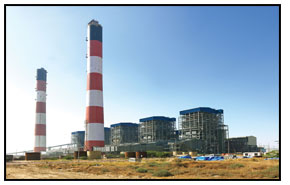
India is making slow
but steady progress
in its endeavour of
adding thermal power
capacity using
supercritical
technology. India's
inherent dependence
on coal-fired power
plants cannot be
wished away and
deploying this
efficient technology is
a viable means to
mitigate the carbon
footprint.
Venugopal Pillai
takes a look at recent
developments in the
supercritical power
equipment business.
India made a modest beginning in deploying
supercritical technology way back in 2004 but it is
only in the past two years that there is visible progress.
India's objectives are twofold. First, the country needs
to expeditiously set up supercritical power plants with a
view to ensuring efficiency in power generation, and
second, it needs to create a local base for equipment and
services in the field supercritical power plants. Today, there
is considerable progress on the first count, and on the
second, a sound beginning has been made.
According to a special study by Electrical Monitor, orders
for supercritical power equipment (boilers and turbinegenerators)
aggregating around 51,500 mw were placed by
Indian power producers, as of mid-March 2012. Another
12,000 mw of orders are on the verge of finalisation. (See
Section NTPC's mega tender.) An important point to note
is that Chinese suppliers are currently playing a very
dominant role. However, as we move in time, a domestic
manufacturing base will emerge as a formidable force—the
incipient signs of which are conspicuous today.
SUPERCRITICAL POWER PROJECTS AWARDED* |
| Developer |
Project |
Capacity (mw) |
Boiler |
Turbine-Generator |
| |
|
Units |
Total |
|
|
| Public Sector and JVs |
| APGenco+IL&FS |
Krishnapatnam, Andhra Pradesh |
2x800 |
1,600 |
Bharat Heavy Electricals |
L&T-MHI |
| Karnataka Power Corporation |
Bellary, Karnataka |
1x700 |
700 |
Bharat Heavy Electricals |
Bharat Heavy Electricals |
| KPCL+BHEL |
Raichur, Karnataka |
2x800 |
1,600 |
Bharat Heavy Electricals |
Bharat Heavy Electricals |
| Mahagenco |
Koradi, Maharashtra |
3x660 |
1,980 |
L&T-MHI |
L&T-MHI |
| NTPC |
Sipat (Stage 1), Chhattisgarh |
3x660 |
1,980 |
Doosan Heavy Inds, Korea |
OJSC Power Machines Group, Russia |
| NTPC |
Barh (Stage 1), Bihar |
3x660 |
1,980 |
Technoprom Export, Russia |
OJSC Power Machines Group, Russia |
| NTPC |
Barh (Stage 2), Bihar |
2x660 |
1,320 |
Bharat Heavy Electricals |
Bharat Heavy Electricals |
| NTPC |
Kudgi, Karnataka |
3x800 |
2,400 |
Doosan Heavy Inds, Korea |
Toshiba-JSW |
| TNEB+BHEL |
Udangadi, Tamil Nadu |
2x800 |
1,600 |
Bharat Heavy Electricals |
Bharat Heavy Electricals |
| Private Sector |
| Adani Power |
Mundra, Gujarat (Unit 5 - 9) |
5x660 |
3,300 |
Harbin, China |
SEPCO III, China |
| Adani Power |
Tirora, Maharashtra (Unit 1 - 3) |
3x660 |
1,980 |
Babcock, China |
BSTG, China |
| CLP India |
Jhajjar, Haryana |
2x660 |
1,320 |
SEPCO III, China |
SEPCO III, China |
| Dainik Bhaskar Power |
Singrauli, Madhya Pradesh |
2x660 |
1,320 |
Bharat Heavy Electricals |
Bharat Heavy Electricals |
| Essar Power |
Salaya (Phase II), Gujarat |
2x660 |
1,320 |
Harbin, China |
Toshiba Corporation, Japan |
| Jaypee Associates |
Nigrie, Madhya Pradesh |
2x660 |
1,320 |
L&T-MHI |
L&T-MHI |
| Jaypee Associates |
Prayagraj, Uttar Pradesh |
3x660 |
1,980 |
Bharat Heavy Electricals |
Bharat Heavy Electricals |
| Lanco Infratech |
Babandh, Orissa |
2x660 |
1,320 |
Dongfang Electric, China |
Dongfang Electric, China |
| Lanco Infratech |
Amarkantak (U3 & U4), Chhattisgarh |
2x660 |
1,320 |
Dongfang Electric, China |
Dongfang Electric, China |
| Lanco Infratech |
Mahanadi, Maharashtra |
2x660 |
1,320 |
Dongfang Electric, China |
Dongfang Electric, China |
| Reliance Power |
Sasan UMPP, Madhya Pradesh |
6x660 |
3,960 |
Shanghai Electric, China |
Shanghai Electric, China |
| Reliance Power |
Krishnapatnam UMPP, AP |
6x660 |
3,960 |
Shanghai Electric, China |
Shanghai Electric, China |
| Reliance Power |
Chitrangi, Madhya Pradesh |
6x660 |
3,960 |
Shanghai Electric, China |
Shanghai Electric, China |
| Reliance Power |
Tilaiya UMPP, Jharkhand** |
6x660 |
3,960 |
Shanghai Electric, China |
Shanghai Electric, China |
| Tata Power |
Mundra UMPP, Gujarat |
5x800 |
4,000 |
Doosan Heavy Inds, Korea |
Toshiba Corporation, Japan |
| Total |
|
|
51,500 |
|
|
| *As of March 23, 2012. List may not be exhaustive. |
A. FOREIGN SUPPLIERS
Role of China: The role of China in India's supercritical
equipment business has been profound. China has landed
orders aggregating over 27,000 mw that represents nearly
half the total orders placed by Indian power producers so far.
Shanghai Electric has been a very dominant name thanks
to its co-operation agreement with Reliance Power (Anil
Ambani Group). In October 2010, Reliance ADA Group
entered into a mega $8.3-billion agreement with Shanghai
Electric to supply 36 supercritical power units. The two
entities also agreed to co-operate on a host of other matters
in the power sector. Shanghai Electric Group has won
orders for equipment (boilers and turbine-generators) for
17,160 mw worth of supercritical power capacity.
Dongfang Electric of China has been a favourite for the
Lanco group that has placed orders for six
sets of 660-mw units. Unconfirmed reports
suggest that Lanco has also planned to
source subcritical and supercritical
equipment from Harbin of China. No
confirmation to this effect was
immediately available.
Other Chinese suppliers catering to the
Indian supercritical power equipment
market include SEPCO III, Harbin, BSTG
and Babcock China. Apart from Reliance
(ADA) Group, Chinese suppliers have
found favour with other private power producers like Adani, Essar and CLP India. In fact, none of
orders won by Chinese suppliers for supercritical power
equipment has been from the government sector—either
Central or state. It is expected that private power
producers will continue to order Chinese equipment, more
because there is no immediate alternative. Once domestic
equipment capacity gets built, the situation might
change. In the medium term though, there is no sign of
Chinese dominance easing off. It may also be mentioned
that the local manufacturing industry had demand higher
duty on import power generation equipment mainly to
thwart Chinese competition. However, this demand has
not yet been acceded to. In the foreseeable future,
therefore, China has very little competition.
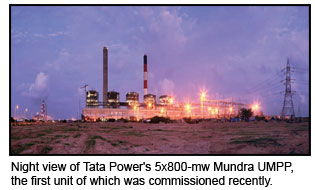
Role of other foreign suppliers: Going forward, the role
of foreign suppliers (except Chinese) would be through joint
ventures forged with Indian companies. However, foreign
suppliers, in individual capacity, have won orders placed in
the past. For instance, the very first orders for supercritical
equipment were placed by NTPC on two foreign suppliers
like Technopromexport and OSJC Power Machines Group
(both from Russia) and Doosan Heavy Industries from
Korea. The Russian suppliers mentioned haven't had any
success after that, but Doosan Heavy Industries did receive
some orders—from Tata Power for the Mundra UMPP and
more recently from NTPC for the Kudgi project. For Both
these projects, Doosan is mandated to supply the 800 mwrated
boilers. Since Doosan is planning to set up a local
manufacturing base in the country, it stands a good chance
to qualify even for providing equipment to public sector
projects. Government entities, ostensibly with a view to
obviate Chinese suppliers in the tendering process, demand
that suppliers have a local manufacturing base.
JVS FOR SUPERCTIICAL EQUIPMENT |
| Name of JV |
Local Company |
Equity |
Foreign Partner |
Equity |
Location |
Equipment |
| |
|
(%) |
|
(%) |
|
|
| L&T-MHI Boilers Pvt Ltd |
Larsen & Toubro |
51 |
Mitsubishi Heavy Inds, Japan |
49 |
Gujarat |
B |
| L&T-MHI Turbine Generators Pvt Ltd |
Larsen & Toubro |
51 |
Mitsubishi Heavy Inds, Japan |
49 |
Gujarat |
TG |
| Toshiba JSW Turbine & Generator Pvt Ltd |
JSW Group |
25 |
Toshiba, Japan |
75 |
Tamil Nadu |
TG |
| Alstom Bharat Forge Ltd |
Bharat Forge |
49 |
Alstom, France |
51 |
Gujarat |
TG |
| Thermax Babcock & Wilcox Ltd |
Thermax |
51 |
Babcock & Wilcox, USA |
49 |
Maharashtra |
B |
| BGR Turbines Company (P) Ltd |
BGR Energy |
74 |
Hitachi Ltd, Japan |
26 |
Tamil Nadu |
B |
| BGR Boilers Pvt Ltd |
BGR Energy |
70 |
Hitachi Power Europe, Germany |
30 |
Tamil Nadu |
TG |
| B=Boilers, TG=Turbine-Generators |
B. LOCAL SUPPLIERS
BHEL: Bharat Heavy Electricals Ltd has been the traditional
supplier of power generation equipment to Indian power
plants. This was very much the case when power generation was solely in the hands of public sector entities. When India
embarked on its supercritical technology endeavour, it was
naturally expected BHEL would extend its role. However,
this was not to be. When NTPC embarked on two
supercritical power plants (Sipat in Chhattisgarh and Barh in
Bihar), the tendering process was put on hold for BHEL to
acquire competency and participate in the bidding process.
However, BHEL could not acquire the technology on time,
and both the projects were delayed only to be finally supplied
by international supercritical power equipment players.
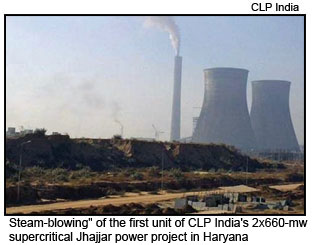
In the supercritical business, 's success has been
mixed. The Central PSU engineering company has won
orders worth 10,120 mw of equipment—in most cases,
both boilers and turbine-generators. The orders have
come from both public and private sector companies.
Apart from securing orders through nomination or
through competitive bidding, the PSU engineering
company has also used the "developer" route. BHEL has
so far formed two joint ventures with state power
generation utilities to develop supercritical power
projects. While BHEL would have a minority (26 per
cent) stake in the JVs, the engineering company would
be the de facto supplier of power equipment. The two
JVs formed are with Tamil Nadu Electricity Board (now
bifurcated) and Karnataka Power Corporation. In both
the cases, the power plants will employ 800 mw-rated
supercritical units.
India's demand for power generation capacity—both
supercritical and conventional—has grown at such a
phenomenal pace that it would be physically impossible
for BHEL to match the demand. Today, BHEL is indeed
contending with an inevitably declining market share,
facing competition from domestic as well as international
players. Going forward, BHEL's success will be governed
by market forces and it faces true competition from
domestic as well as international companies.
Joint ventures: The emergence of joint ventures
between Indian and foreign companies in the power
equipment space, and more so in the supercritical arena, is a
defining moment for the Indian power sector. So far, at least
five collaborations are in play and in some cases, the partners
have even commissioned their equipment manufacturing
plants. Here is a brief note on each of the JVs.
L&T-MHI: In January 2011, Larsen & Toubro and its
joint venture partner Mitsubishi Heavy Industries
commissioned its twin manufacturing facilities for
supercritical equipment at Hazira in Gujarat. The two
facilities will produce supercritical boilers and turbinegenerators,
respectively. The indicative capacity of the
plants is 5,000 mw per year, and L&T has 51 per cent stake
in each of the ventures. L&T-MHI secured its first order
when it won the turbine-generator package of the 2x800-
mw Krishnapatnam supercritical project developed by a
joint venture between APGenco and IL&FS. Later, L&TMHI
won the BTG package for Jaypee's Nigrie project
(2x660-mw) and Mahagenco's Koradi project (3x660-mw).
L&T-MHI is also a strong contender for the NTPC's mega
tender, which has been discussed separately.
NTPC'S BULK TENDERING |
| Project |
State |
Capacity |
| |
|
(mw) |
| Mauda (Stage II) |
MAH |
2 x 660 |
| Solapur |
MAH |
2 x 660 |
| Nabinagar |
BIH |
3 x 660 |
| Meja |
UP |
2 x 660 |
| Raghunathpur (Stage II)* |
WB |
2 x 660 |
| Kudgi |
KAR |
3 x 800 |
| Darlipali |
ORI |
2 x 800 |
| Gajmara |
ORI |
2 x 800 |
| Lara |
CHH |
2 x 800 |
| Total for 9 projects |
|
14,460 |
| *For Damodar Valley Corporation |
JSW-Toshiba: In February this year, the turbinegenerator
manufacturing facility of the joint venture
between JSW Energy and Toshiba Corporation of Japan
turned operational. The two partners joined forces in late
2008 to set up a $160-million facility in Tamil Nadu. The
new facility will produce high-efficiency steam turbines
and generators for supercritical thermal power plants, in
generating capacities ranging from 500 mw and 1,000 mw.
The plant's annual production capacity, currently at
around 3,000 mw, will be doubled to 6,000 mw by March
2015. It will form a major manufacturing hub serving the
global markets, alongside Toshiba's manufacturing base in
Japan, a statement from Toshiba Corporation observed.
Export destinations will include Middle East and
Southeast Asia. The joint venture Toshiba JSW Turbine &
Generator Pvt Ltd has so far won an order from NTPC to
supply three supercritical turbine-generator sets for the
Kudgi project in Karnataka.
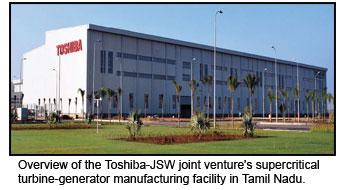 Alstom-Bharat Forge:
Alstom-Bharat Forge: The joint venture is ready with
its manufacturing facility in Gujarat for supercritical
turbine-generators. Alstom Bharat Forge Power Ltd has
emerged as L1 for NTPC's tender for sourcing 660-mw
supercritical turbine-generators. The JV is awaiting
NTPC's final award to start production.
Thermax-Babcock: Thermax, the Pune-based
engineering company, formed a joint venture with its longstanding
partner Babcock & Wilcox of USA. Thermax
Babcock & Wilcox Ltd, in which the Indian partner holds
51 per cent stake is developing a manufacturing facility
near Pune in Maharashtra for advanced boiler systems for
supercritical plants.
BGR-Hitachi: In August 2010, Chennai-based BGR
Energy Systems formed two joint ventures with Hitachi of
Japan for manufacture of supercritical power equipment.
This marked the entry of BGR Energy, till then a leading
player in the balance-of-plant space, in the turnkey EPC
contracting for power generation plants. The first joint
venture BGR Turbines Company (P) Ltd was formed with 26
per cent holding by Hitachi Ltd. The second, for boilers,
called BGR Boilers Pvt Ltd, has Germany-based Hitachi
Power Europe GmbH as its 30-per cent equity partner. The
manufacturing facilities of both the plants are in advanced
stage of completion. BGR-Hitachi, according to reliable
estimates, is likely to get its first orders soon. NTPC is on the
verge of mandating the JV to supply four turbine-generators
of 800-mw each.
NTPC'S MEGA SUPERCRITICAL TENDER:
THE BIG PUSHNTPC is in the midst of finalizing a bulk tendering process
for supercritical power units, both of 660-mw and 800-mw.
For suppliers—both traditional and new-generation—this
represents a big business driver. NTPC is procuring as many
as 19 supercritical power units of which 11 are of 660-mw
variety and nine are of the advanced 800-mw variety. The
aggregate size of the order is 14,460 mw (See Table).
In the first round, initiated in 2010, NTPC sought 11 units
(boilers and turbine-generators) of 660-mw each. This
included nine units for its own projects and two units for
Damodar Valley Corporation. The bidding process has been
delayed as some bidders moved court following their
disqualification. The tendering routine was revived after the
Supreme Court in February this year overruled a Delhi High
Court judgement. In March 2011, the Delhi High Court had
upheld the plea of a consortium of Ansaldo and Gammon
against its disqualification by NTPC. Results of this tender
would be finalized by April end. For the boiler packages,
players in the fray include Bharat Heavy Electricals Ltd,
Larsen & Toubro (in JV with Mitsubishi), BGR Energy (in JV with Hitachi), etc. For the turbine package, applicants
include Bharat Forge-Alstom, Toshiba-JSW, BHEL, etc.
According to information available, BGR Energy Systems
has emerged L1 in the boilers component, while BHEL is a
strong contender in the turbine-generator component.
What is supercritical technology? |
The term "supercritical" refers to main steam operating
conditions, being above the critical pressure of water (221.5
bar). The significance of the critical point lies in the difference in
density between steam and water. Above the critical pressure
there is no distinction between steam and water, i.e. above 221.5
bar, water is a fluid.
In supercritical cycle, equipment is designed to operate above the
critical pressure of water. Supercritical boilers are once-through
where in the feedwater enters the economiser and flows through
one path and main steam exits the circuit. Typically current
supercritical units operate at 242 bar main steam pressure, 565ºC
main steam temperature and 593ºC reheat steam temperature.
Supercritical steam conditions improve the turbine cycle heat
rate significantly over subcritical steam conditions. Overall
supercritical power plant efficiency of around 42% is achievable
with current supercritical parameters. Improved heat rate results
in a 5 per cent reduction in fuel consumption, leading to a 5 per
cent reduction in CO2 emissions per MWh energy output.
(Source: Larsen & Toubro)
|
NTPC is also likely to soon finalize contracts for nine
supercritical power units of 800-mw each. These nine units
are to be deployed at Kudgi (Karnataka), Darlipali and
Gajmara (both Orissa) and Lara (Chhattisgarh). Speaking to
Electrical Monitor, a senior official from NTPC said that while
some contracts have been finalized, some are held up due to
land-related issues. He explained that since the contracts are
for supply and erection of equipment, they can be finalized
only when there is sufficient progress on land acquisition at
the project sites. While the contract for the Kudgi project has
been finalized, land-related hurdles are delaying award of
contracts for the Darlipali and Lara projects.
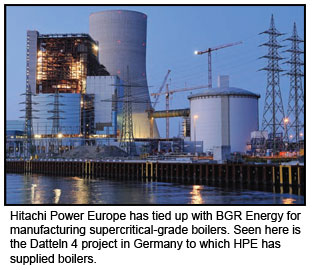
The NTPC official elaborated that for the 3x800-mw
Kudgi project, Toshiba-JSW Turbine Generators Pvt Ltd
has been selected to supply turbine-generators, while
boilers will be supplied by Doosan of Korea. The boiler
order will be executed by Doosan Chennai Works, the
Korean company's local manufacturing unit. It is reliably
learnt that BGR Energy Systems Ltd, which has formed
joint ventures with Hitachi Power GmbH will be
supplying four turbine-generator units of 800-mw each, to
be deployed at the Darlipali and Lara sites. Doosan will
also receive the mandate for two more boilers. Bharat
Heavy Electricals, according to reliable sources, will be
entitled to supply four boiler sets and two TG sets. The JV
between Larsen & Toubro and Mitsubishi Heavy
Industries is also expected to land orders to supply 800-
mw rating boilers and turbine-generators.
SUPERCRITICAL UNITS COMMISSIONED
Power plants based on supercritical technology are today a
reality in India. So far, three power producers have
commissioned supercritical power units. The credit for
commissioning India's first power plant with supercritical
technology goes to the Adani Group. In December 2010, the
private business group commissioned the first unit of 660-mw of its Mundra power project (Phase 2) in Gujarat. The unit was
commissioned in a record time of 36 months from zero date.
In June 2011, NTPC brought online the first 660-mw
unit of its Sipat (Phase 1) power project in Chhattisgarh. It
was widely believed that NTPC's Sipat project would be
India's first power project on supercritical parameters.
Although the contract was placed way back in April 2004,
there was inordinate delay on part of the Russian
contractors and suppliers.
Adani and NTPC subsequently commissioned
more units of their respective projects. (See Table)
Tata Power takes credit for commissioning India's
largest power unit when the first unit of the 5x800-mw
Mundra UMPP being developed in Gujarat by
special purpose vehicle Coastal Gujarat Power Ltd was
brought online.
CLP India also commissioned the first unit of its 2x660-
mw Jhajjar supercritical power project in January this year.
The unit began commercial production in March. This
project, incidentally, is the first power generation project
awarded on tariff-based competitive bidding.
As of March 23, 2012, India had at least seven
supercritical power units aggregating 4,760 mw in
operation. The achievement has been a collective effort of
Chinese, Russian, Japanese and Korean suppliers. All said,
India still awaits supercritical power plants equipped units
with domestic equipment.
It may be mentioned that there were unconfirmed
reports of three more units of 660-mw supercritical power
units commissioned by Adani Power—one unit at Mundra
and two at its Tirora plant in Maharashtra. Details could
not be confirmed till the time of writing.
OUTLOOK
The outlook for supercritical power equipment is
cautiously optimistic. The optimism emanates from the
sheer fact that India would be very inclined to use
supercritical technology in its future coal-fired plants.
Despite all its efforts to promote clean energy sources, coalfired
power plants will continue to be the mainstay for
meeting base load. Supercritical power plants therefore
offer an avenue to at least mitigate some of the environment-related adversities associated with
conventional (subcritical) power plants.
Supercritical Units Commissioned* |
| Developer |
Month |
Project |
Capacity |
| |
|
|
(mw) |
| Adani Power |
Dec-10 |
Mundra (Unit-5), GUJ |
660 |
| NTPC |
Jun-11 |
Sipat (Phase-1, Unit-1), CHH |
660 |
| Adani Power |
Jul-11 |
Mundra (Unit-6), GUJ |
660 |
| NTPC |
Nov-11 |
Sipat (Phase-1, Unit-2), CHH |
660 |
| Adani Power |
Nov-12 |
Mundra (Unit-7), GUJ |
660 |
| CLP India |
Jan-12 |
Jhajjar (Unit-1), HAR |
660 |
| Tata Power |
Mar-12 |
Mundra UMPP (Unit-1), GUJ |
800 |
| Total for seven units |
4,760 |
| *As of March 23, 2012; List may not be exhaustive |
Power producers,both private and government-owned,
are increasingly opting for supercritical power plants.
Apart from being environment-positive, supercritical
power plants are of large unit-sizes (660 mw, 800 mw, etc)
thereby offering economies of scale. Industry experts feel
that large unit-size power plants also less land-centric,
which means that they take up less land per mw than
conventional (lower unit-size) plants.
The caution in the optimism comes from the fact that
India is yet to have a track record for supercritical power
plants for domestic conditions. Although supercritical
power plants have been in operation worldwide even for
decades, experts point out to the fact that Indian coal,
though available in abundance, is of inferior quality. For
supercritical power plants to work at optimum levels, the
coal used should be of the imported grade. Although many
supercritical power plants, such as the coastally-located
UMPPs, will be fired with imported coal, there are
concerns surrounding availability of imported coal at
competitive prices.
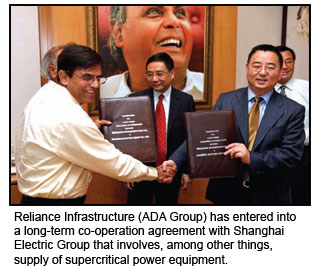
It is estimated that 60 per cent of the total thermal power
capacity to be added in the XII Plan period (FY13 to FY17)
will be through supercritical technology. In the XIII Plan
period (FY18 to FY22), the entire envisaged thermal power
capacity addition will be through supercritical plants.
With respect to its supercritical ambitions, India appears to
be on track.
Data compiled by Electrical Monitor reveals that orders
worth around 45,000 mw have been placed for supercritical
power equipment. Another 12,000 mw or so is expected
from the mega NTPC tender that is scheduled to be
finalized by the first quarter of FY13. With this, the targets
for the XII Plan period seem attainable.
The ensuing financial year, 2012-13, will be a
determinant of sorts for the supercritical power
equipment industry. This is for several reasons. Firstly,
supplies from local manufacturers are expected to begin.
Till now, all the equipment commissioned is from
foreign suppliers. Local suppliers would include the
several partnerships between Indian and foreign
companies, discussed earlier. Even Bharat Heavy
Electricals Ltd, with several orders under its belt, is also
expected to begin its supplies during FY13. In the next 1-
2 years, the 4,000-mw of supercritical power plants
already commissioned will be in regular operation. This
will form the foundation of India's experience with
running supercritical power plants.
Amidst the overall excitement in ushering the
supercritical technology era, there are genuine concerns
regarding surplus capacity. Going by the upcoming jointventure
manufacturing plants, new capacity of at least
20,000 mw is under creation. This does not include
Chinese suppliers. In the medium term, India's demand for
supercritical power equipment, as estimated by Electrical
Monitor, would be in the range of 13,000 mw to 15,000 mw
per year. Hence, there is a possibility of excess supply,
possibly leading to competitive pricing. This is already
evident in the mega tender of NTPC where rates quoted by
Indian suppliers have been significantly lower than those
seen in previous orders. All this bodes well for power
producers and ultimately the consumer who could
possibly look forward to lower tariffs.
In summary, India has made a good beginning in its
supercritical endeavours. The next couple of years will
determine how effectively this new culture spreads on the
power canvas.
Advanced ultra supercritical |
India has taken initial steps to build India's first coal-fired 800-mw
advanced ultra supercritical thermal power plant. A tripartite
agreement between NTPC, BHEL and Indira Gandhi Centre for
Atomic Research (IGCAR) has been signed to this effect. The plant
is expected to be operational by 2017. While BHEL would design
and manufacture the equipment, testing would be done by IGCAR.
NTPC will be the project implementing agency. R&D activities on
the new technology have already started and the equipment should
be ready in about two years hence. Advanced ultra supercritical
power plants will have even more efficiency compared with
supercritical power plants. The technology will result in around 12
per cent lower coal consumption leading to lower carbon footprint. |